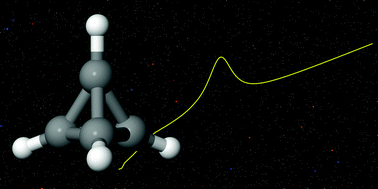Polycyclic aliphatic hydrocarbons: is tetrahedrane present in UIR spectra?†
Abstract
The smallest Platonic hydrocarbon, tetrahedrane, has been subject to frequent theoretical and experimental study for 50 years, but its infrared spectrum and synthetic pathway remain a mystery. The recent partial attribution of the ultraviolet extinction bump observed in the interstellar medium (ISM) of the Milky Way galaxy to hydrogenated T-carbon, a larger tetrahedral cluster formed from tetrahedrane and C4 monomers, has brought renewed interest to the molecule. Similarly, as a polycyclic hydrocarbon, tetrahedrane is similar in structure to the molecules proposed to be responsible for the so-called unidentified infrared bands (UIRs) observed in all kinds of astronomical environments. Furthermore, tetrahedrane's ν2 and ν7 fundamental vibrational frequencies, with values of 3210.6 cm−1 (3.11 μm) and 752.5 cm−1 (13.29 μm) as computed in the present quantum chemical study, have substantial intensities of 59 and 183 km mol−1, respectively. These come tantalizingly close to, but potentially distinct from, the 3.3 and 13.2 μm regions of the infrared spectrum typically included in the UIRs. As such, tetrahedrane or related clusters of these polycyclic aliphatic hydrocarbons may have a role to play in both of these sets of observations and could even help to explain the relation between them. Regardless, if tetrahedrane is present in the ISM, the highly-accurate theoretical data reported herein should help to aid in its identification and may assist in guiding future synthetic experiments as well.



 Please wait while we load your content...
Please wait while we load your content...